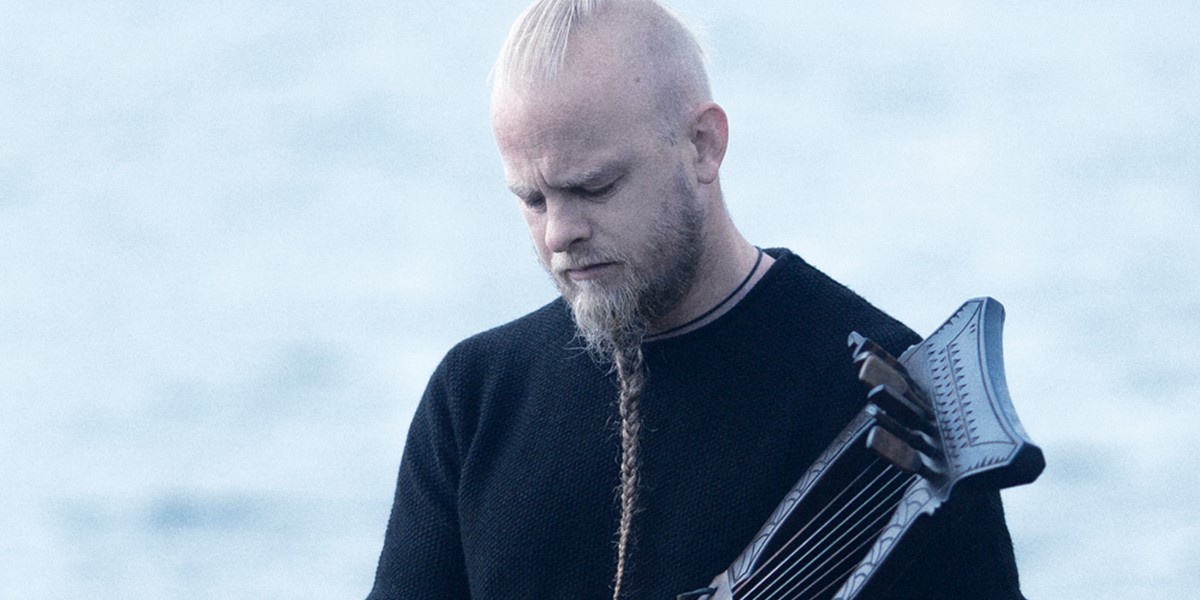Tuesday, June 29, 2021
Kravik-lyre | Musical Instrument Guide (with Wardruna’s Einar Selvik)
By Tony Gillam
Tony Gillam speaks to Wardruna’s multi-instrumentalist Einar Selvik about his kravik-lyre and how he connects with Norway’s folk music tradition

Einar Selvik (photo: Daria Endresen)
The one-time drummer with black metal band Gorgoroth, Einar Selvik is nowadays better known for Wardruna – the ‘Norwegian folk music constellation’ whose album Kvitravn (reviewed in the Jan/Feb issue, #164) topped the charts in several countries. As a singer, multi-instrumentalist and composer for TV series and video games Selvik has become the ‘go-to’ musician for anyone needing a Viking soundtrack.
“I have quite an arsenal of strange instruments,” admits Selvik. Along with the goat horn and the taglharpa, he has a special affection for the kravik-lyre, a small seven-stringed harp. Its strings are tuned to the notes ACDEFGA. Seven notes might seem restrictive, but Selvik says the limitations “sharpen your creativity.”
The original kravik-lyre came to light in the 19th century in Numedal, Norway, on a medieval farm. Unlike the Anglo-Saxon lyre unearthed at Sutton Hoo this wasn’t an archaeological find – the farm owners had kept it as an heirloom. Now in Oslo’s Folk Museum, carbon-dating has shown it dates from the 16th century. The kravik-lyre was superseded in Northern Europe by multi-stringed harps and various bowed instruments.
Selvik’s instrument was built by fellow Norwegian Sverre Heimdal. Other notable modern makers include English luthier Michael J King (who also offers a hybrid alternative – the Viking lyre, built by assembling pieces rather than carving the whole lyre from a solid piece of pine). In Norway, there were a few other players, but Selvik deliberately avoided listening to them, preferring to explore it in a child-like way, hoping to find the instrument’s own voice. Selvik uses two main techniques – plucking the strings individually in a pattern and ‘stop and strum’ (meaning stopping or muting the strings you don’t want with the left hand, while sounding the remaining strings with the right). It’s a quiet instrument that demands an attentive audience, ideal for accompanying poetry and storytelling.
In 2017 Selvik performed at Søre Kravik – the farm where the original instrument was found. When I mention this, Selvik confesses to getting goosebumps: “It was a special feeling, to bring it home and to play to the descendants of the people who lived there, surrounded by old wooden buildings dating back to the Black Death.” He feels privileged to have played in what he calls “time-right settings” – places redolent of the kravik-lyre’s medieval past – “iron-age longhouses over a crackling fire, and the royal feasting hall at Bergen.”
Selvik’s goal is not to replicate the music of a specific time; his soundscape is modern. His serious, scholarly approach has seen him speak at Oxford University on music, poetry and performance. “It’s important,” he reflects, “not to climb trees that don’t have roots, to stand on solid ground before going into the more intuitive, creative process.”
His involvement with TV series Vikings saw Selvik playing his kravik-lyre in front of the camera. The directors had come across Warduna’s music and invited him to help them make music central to the drama. Selvik is equally proud of his soundtrack for the video game Assassin’s Creed Valhalla: “I appreciated how the producers wanted to highlight the oral, poetic tradition.”
As for the success of Warduna’s latest album, he says, “I do what I do; if people connect to it that’s a fantastic bonus.” He thinks its popularity is due to people’s longing for a connection to nature. “My music is about our relationship with nature; it provides a bridge, and a medicine, for that longing.”
Last year, Selvik performed ‘Voluspá’ (a medieval poem describing the beginning and end of the world according to Norse mythology), accompanied by the Bergen Philharmonic Orchestra and the Edvard Greig Choir. “As the centre of the piece I was kind of the conductor,” he recalls. “They had to follow me… Becoming one with the words is important – I have to become the song; I have to disappear.”
This article originally appeared in the June 2021 issue of Songlines. Never miss an issue – subscribe today

